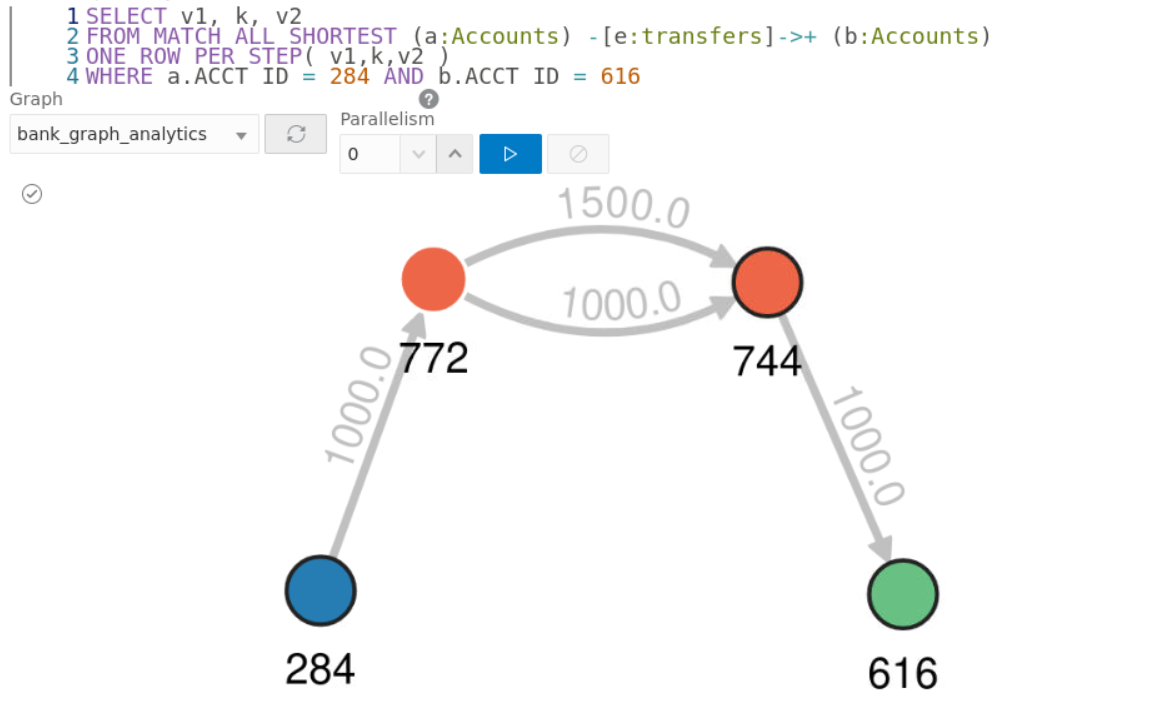6.8.3.2 Unnesting of Variable-Length Path Queries
Unnesting of variable-length path queries (such as, SHORTEST or
CHEAPEST paths) to obtain a separate row for each vertex or edge
along a path is supported.
ONE ROW PER MATCH(default option)ONE ROW PER VERTEX(vertex_variable)ONE ROW PER STEP(edge_source_variable,edge_variable,edge_destination_variable)
For example, the following PGQL query uses the ONE ROW PER
STEP option:
SELECT v1.ACCT_ID AS src_no, k.TXN_AMOUNT, v2.ACCT_ID AS dest_no
FROM MATCH ALL SHORTEST (a:Accounts) -[e:transfers]->+ (b:Accounts)
ONE ROW PER STEP( v1,k,v2 )
WHERE a.ACCT_ID = 284 AND b.ACCT_ID = 616It is important to note that the ONE ROW PER STEP option
only supports paths with a minimal hop greater than 0 and hence * quantifier is not
supported with this option.
On execution, the preceding query retrieves one row for every edge on the path that is bound by the corresponding source and destination vertices:
+-------------------------------+
| src_no | TXN_AMOUNT | dest_no |
+-------------------------------+
| 744 | 1000.0 | 616 |
| 772 | 1000.0 | 744 |
| 284 | 1000.0 | 772 |
| 744 | 1000.0 | 616 |
| 772 | 1500.0 | 744 |
| 284 | 1000.0 | 772 |
+-------------------------------+You can also use the Graph Visualization tool to visualize edges using ONE ROW
PER STEP along a path:
Figure 6-1 Visualizing Unnesting of Variable-Length Path Queries

Description of "Figure 6-1 Visualizing Unnesting of Variable-Length Path Queries"
An example for a query with the ONE ROW PER VERTEX option
is as follows:
SELECT k.acct_id AS id, k.acct_name AS name
FROM MATCH ANY SHORTEST (a:Accounts) ((src:Accounts)-[e:transfers]->){1,3}(b:Accounts)
ONE ROW PER VERTEX(k)
WHERE a.acct_id=284 AND b.acct_id=616On execution, the preceding query retrieves one row per vertex along a path:
+----------------+
| id | name |
+----------------+
| 616 | Account4 |
| 744 | Account3 |
| 772 | Account2 |
| 284 | Account1 |
+---------------+
Built-in Function Support for Recursive Path Unnesting Queries
PGQL supports the following two built-in functions, which can be used in
combination with any of the path unnesting option (ONE ROW PER
VERTEX, ONE ROW PER STEP or ONE ROW PER
MATCH):
MATCH_NUMBER(k): Returns a unique per-path identifier for each unnested path (that is, if two rows come from the same path, they have the sameMATCH_NUMBER(k)).ELEMENT_NUMBER(k): Returns the element number of a vertex or an edge along a path. Vertices are numbered with odd numbers, the leftmost vertex is numbered1, the second3, then5and so on. Edges are assigned with even numbers, starting with2for the leftmost edge,4for the next one, and so on.
For example, the following PGQL query uses the MATCH_NUMBER(k) and
ELEMENT_NUMBER(k) functions with ONE ROW PER
VERTEX option:
SELECT k.*, match_number(k), element_number(k)
FROM MATCH ANY SHORTEST (a:Accounts) -[e:transfers]->* (b:Accounts) ONE ROW PER VERTEX ( k )
WHERE a.acct_id = 284 AND b.acct_id = 616The preceding query produces the following output on execution. Note that the
element_number(k) returned for the vertices are odd numbered
values. Since the preceding query uses ANY path pattern, there is
only one arbitrary path displayed in the output. Therefore
match_number(k) is the same for all the rows in the path.
+-----------------------------------------------------------+
| ACCT_ID | ACCT_NAME | match_number(k) | element_number(k) |
+-----------------------------------------------------------+
| 616 | Account | 0 | 7 |
| 744 | Account | 0 | 5 |
| 772 | Account | 0 | 3 |
| 284 | Account | 0 | 1 |
+-----------------------------------------------------------+
The following example shows a PGQL query using
MATCH_NUMBER(k) and ELEMENT_NUMBER(k)
functions with ONE ROW PER STEP option:
SELECT v1.acct_id AS src_no,k.txn_amount,v2.acct_id AS dest_no, match_number(k), element_number(k)
FROM MATCH ALL SHORTEST (a:Accounts) -[e:transfers]->+ (b:Accounts)
ONE ROW PER STEP( v1,k,v2 )
WHERE a.acct_id = 284 AND b.acct_id = 616The preceding query output is as shown. Note that there are two paths
identified by match_number(k)and the edges are displayed with even
numbered element_number(k) values.
+---------------------------------------------------------------------+
| src_no | txn_amount | dest_no | match_number(k) | element_number(k) |
+---------------------------------------------------------------------+
| 744 | 1000.0 | 616 | 0 | 6 |
| 772 | 1000.0 | 744 | 0 | 4 |
| 284 | 1000.0 | 772 | 0 | 2 |
| 744 | 1000.0 | 616 | 1 | 6 |
| 772 | 1500.0 | 744 | 1 | 4 |
| 284 | 1000.0 | 772 | 1 | 2 |
+---------------------------------------------------------------------+Parent topic: PGQL Features Supported in the Graph Server (PGX)